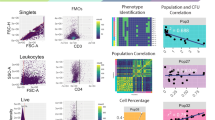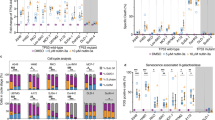Abstract
Intracellular assays of signaling systems have been limited by an inability to correlate functional subsets of cells in complex populations on the basis of active kinase states. Such correlations could be important in distinguishing changes in signaling status that arise in rare cell subsets during functional activation or in disease manifestation. Here we demonstrate the ability to simultaneously detect activated kinase members of the mitogen-activated protein kinases family (p38 MAPK, p44/42 MAPK, JNK/SAPK), members of cell survival pathways (AKT/PKB), and members of T-cell activation pathways (TYK2), among others, in subpopulations of complex cell populations by multiparameter flow-cytometric analysis. We demonstrate the utility of these probes in identifying distinct signaling cascades for (1) both artificial and physiological stimulatory conditions of peripheral blood mononuclear cells (PBMCs), (2) cytokine stimulation in human memory and naïve lymphocyte subsets as identified by five differentiation markers, and (3) ordering of kinase activation in potential signaling hierarchies. Polychromatic flow-cytometric active kinase measurements demonstrate that multidimensional analysis of signaling pathways can provide functional signaling pathway assessment on a single-cell level and allow for potential correlation with biological and clinical parameters.
This is a preview of subscription content, access via your institution
Access options
Subscribe to this journal
Receive 12 print issues and online access
$209.00 per year
only $17.42 per issue
Buy this article
- Purchase on Springer Link
- Instant access to full article PDF
Prices may be subject to local taxes which are calculated during checkout






Similar content being viewed by others
References
Fiering, S.N. et al. Improved FACS-Gal: flow cytometric analysis and sorting of viable eukaryotic cells expressing reporter gene constructs. Cytometry 12, 291–301 (1991).
Nolan, G.P., Fiering, S., Nicolas, J.F. & Herzenberg, L.A. Fluorescence-activated cell analysis and sorting of viable mammalian cells based on beta-d-galactosidase activity after transduction of Escherichia coli lacZ. Proc. Natl. Acad. Sci. USA 85, 2603–2607 (1988).
Spinozzi, F. et al. The natural tyrosine kinase inhibitor genistein produces cell cycle arrest and apoptosis in Jurkat T-leukemia cells. Leuk. Res. 18, 431–439 (1994).
Hunter, T. Signaling—2000 and beyond. Cell 100, 113–127 (2000).
De Rosa, S.C., Herzenberg, L.A. & Roederer, M. 11-color, 13-parameter flow cytometry: identification of human naive T cells by phenotype, function, and T-cell receptor diversity. Nat. Med. 7, 245–248 (2001).
Franklin, R.A., Atherfold, P.A. & McCubrey, J.A. Calcium-induced ERK activation in human T lymphocytes occurs via p56(Lck) and CaM-kinase. Mol. Immunol. 37, 675–683 (2000).
Marhaba, R. et al. Tyrphostin A9 inhibits calcium release-dependent phosphorylations and calcium entry via calcium release-activated channel in Jurkat T cells. J. Immunol. 157, 1468–1473 (1996).
Montgomery, R.B., Moscatello, D.K., Wong, A.J., Cooper, J.A. & Stahl, W.L. Differential modulation of mitogen-activated protein (MAP) kinase/extracellular signal-related kinase kinase and MAP kinase activities by a mutant epidermal growth factor receptor. J. Biol. Chem. 270, 30562–30566 (1995).
Morrison, P., Saltiel, A.R. & Rosner, M.R. Role of mitogen-activated protein kinase kinase in regulation of the epidermal growth factor receptor by protein kinase C. J. Biol. Chem. 271, 12891–12896 (1996).
Wang, X., McCullough, K.D., Franke, T.F. & Holbrook, N.J. Epidermal growth factor receptor-dependent Akt activation by oxidative stress enhances cell survival. J. Biol. Chem. 275, 14624–14631 (2000).
Bucciantini, M. et al. The low Mr phosphotyrosine protein phosphatase behaves differently when phosphorylated at Tyr131 or Tyr132 by Src kinase. FEBS Lett. 456, 73–78 (1999).
Nielsen, S.D., Afzelius, P., Ersboll, A.K., Nielsen, J.O. & Hansen, J.E. Expression of the activation antigen CD69 predicts functionality of in vitro expanded peripheral blood mononuclear cells (PBMC) from healthy donors and HIV-infected patients. Clin. Exp. Immunol. 114, 66–72 (1998).
Risso, A. et al. CD69 in resting and activated T lymphocytes. Its association with a GTP binding protein and biochemical requirements for its expression. J. Immunol. 146, 4105–4114 (1991).
Fukuchi, K. et al. Phosphatidylinositol 3-kinase inhibitors, Wortmannin or LY294002, inhibited accumulation of p21 protein after gamma-irradiation by stabilization of the protein. Biochim. Biophys. Acta 1496, 207–220 (2000).
Duncia, J.V. et al. MEK inhibitors: the chemistry and biological activity of U0126, its analogs and cyclization products. Bioorg. Med. Chem. Lett. 8, 2839–2844(1998).
Favata, M.F. et al. Identification of a novel inhibitor of mitogen-activated protein kinase kinase. J. Biol. Chem. 273, 18623–18632 (1998).
DeSilva, D.R. et al. Inhibition of mitogen-activated protein kinase kinase blocks T cell proliferation but does not induce or prevent anergy. J. Immunol. 160, 4175–4181 (1998).
Eyers, P.A., Craxton, M., Morrice, N., Cohen, P. & Goedert, M. Conversion of SB 203580-insensitive MAP kinase family members to drug-sensitive forms by a single amino-acid substitution. Chem. Biol. 5, 321–328 (1998).
Bennecib, M., Gong, C., Grundke-Iqbal, I. & Iqbal, K. Role of protein phosphatase-2A and -1 in the regulation of GSK-3, cdk5 and cdc2 and the phosphorylation of tau in rat forebrain. FEBS Lett. 485, 87–93 (2000).
Breittmayer, J.P., Pelassy, C. & Aussel, C. Effect of membrane potential on phosphatidylserine synthesis and calcium movements in control and CD3-activated Jurkat T cells. J. Lipid Mediat. Cell Signal. 13, 151–161 (1996).
Kiss, Z., Phillips, H. & Anderson, W.H. The bisindolylmaleimide GF 109203X, a selective inhibitor of protein kinase C, does not inhibit the potentiating effect of phorbol ester on ethanol-induced phospholipase C-mediated hydrolysis of phosphatidylethanolamine. Biochim. Biophys. Acta 1265, 93–95 (1995).
Uddin, S., Chamdin, A. & Platanias, L.C. Interaction of the transcriptional activator Stat-2 with the type I interferon receptor. J. Biol. Chem. 270, 24627–24630 (1995).
Rolli-Derkinderen, M. & Gaestel, M. p38/SAPK2-dependent gene expression in Jurkat T cells. Biol. Chem. 381, 193–198 (2000).
Acknowledgements
We are indebted to Steve De Rosa, Leonore A. Herzenberg, and Leonard A. Herzenberg for training in polychromatic flow cytometry. We also thank Gina Jager for flow cytometry preparation, Kevin Marks and Richard Smith for helpful and insightful discussions, and Mark Gilbert for FACStarPlus operation. This work was accomplished under a Scholar's award from the Leukemia and Lymphoma Society of America and a Burroughs Wellcome New Investigator in Pharmacology Award to G.P.N. The work was supported by NIH grants P01-AI39646, AR44565, AI35304, N01-AR-6-2227, A1/GF41520-01, and by the Juvenile Diabetes Foundation.
Author information
Authors and Affiliations
Corresponding author
Supplementary information
Rights and permissions
About this article
Cite this article
Perez, O., Nolan, G. Simultaneous measurement of multiple active kinase states using polychromatic flow cytometry. Nat Biotechnol 20, 155–162 (2002). https://doi.org/10.1038/nbt0202-155
Received:
Accepted:
Issue Date:
DOI: https://doi.org/10.1038/nbt0202-155



